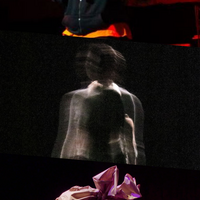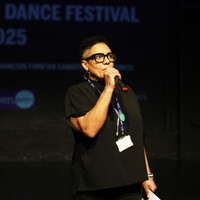Sat 7 May: Gabriella Engdahl/Dom Czapski & Jamie Hamilton/Liam Francis

News Story
Gabriella Engdahl The Normal World
Dom Czapski & Jamie Hamilton Waiting Music
Liam Francis Where to Start?
Posing and fake laughter abound in The Normal World's surrealist vision, where a family full of hot air struggle to present a curated face to the world. Pull, push, pump yourself up! A mother and her two daughters in playful inflatable costumes evocative of Flemish golden age, battle it out for the pump while the servant cleans behind them.The joyous choreography by Gabriella Engdahl makes good use of the props and suggests switching moods: fight and screams, a fainting spell and a bucket-headed pas-de-deux. This is a story of emancipation, although the rapidly shifting pace and quality of movement sometimes make the threads hard to follow. Nonetheless a clever image remains where the daughters revel in freedom from the pump, as their controlling mother lies deflated on the ground.
A bleaker vision of alienation and pretence lies in Waiting Music. A limp body is dragged to the front of the stage, soon washed by incongruous upbeat muzak. Dom Czapski overacts the insurance sales scripts he has to mouth every night to his desperate callers - "the call centre’s lines got crossed with a suicide hotline". Over the electronic bips of disconnected calls, his disjointed limbs gesture to his despair, as he crawls on the floor or frantically gesticulates about fulfilment centres. The interplay of dance, music by Jamie Hamilton and spoken word is precise and inspired but the darkness, relentless.
The least verbose work of the evening, Where to Start? is the most eloquent, in its shifty evocation of discomfort and the stickiness of desire. Liam Francis, who we knew as a dancer of astonishing physicality with Rambert, choreographs here a duet of fluid and distorting bodies with Clark Avery, whose precise movements are full of feelings. The palpable awkwardness dancing between the pair as they sit on a bench is made acute by meticulous clothes readjustments: sweaters need their shoulder repositioned, their length pulled. Clumsy contact -seeking develops into tender partner work, but sours. This attraction expressed in awkward posturing can only be resolved in confrontation and violence, the delicate balance of the relationship broken as Francis ends defeated at the foot of the bench.
Iris Kilian
Gabriella Engdahl’s The Normal World throws into question the facades we display personally, socially and, perhaps more pertinently, through our online worlds. Within a swimming pool setting, we meet three larger-than-life characters costumed in bright inflatable dresses and swimming caps, and a janitor who fruitlessly sweeps around them. Gleefully and desperately the performers pose, preen and pump their ever-deflating costumes, the staccato action of their movements a complement to the awkward angles of their bodies. Strikingly cohesive, each element of this work’s design adds to the artifice of the scenes unfolding on stage - from the fake grass to the life ring suspended hopelessly out of reach above the turquoise blue of a small, tank-like pool. As the forced smiles sporadically falter, we witness these character’s personas inflate and deflate before us - physically, visually and emotionally. Intelligent and funny with an edge of despair, Engdahl and collaborators have crafted an engaging world of polished artificiality.
Dom Czapski & Jamie Hamilton’s Waiting Music takes that tone of wry humour into darker territory. Set in the context of a night shift at a call centre, Czapski, as the main protagonist, narrates a tightly written script that combines dry comedy with moments of cutting directness. Intersected by waiting music and clicking phone lines, and accompanied by a lighting design that shifts between stark spotlit moments and eerie darkness, Waiting Music uncompromisingly encapsulates one man's questioning uncertainty towards the call centre’s dehumanised conversations and his own existential crisis.
There’s a compellingly unsettled quality to Liam Francis’ Where to Start? Performed by Francis and dancer Clark Avery, the duo capture a tone of uncertainty that finds form in the perpetual adjusting of their clothes, bodies and each other. The opening section, choreographed upon and around a low bench, is detailed and precise, Francis and Avery’s casual fidgeting with their clothes morphing into more expansive movements that gradually spill off the bench and into the space. As their legs twist and fold like liquid, entangling their own bodies and one another, there’s a distinct sense of instability and a continual search for support. There are moments where the choreography almost overrides this intention giving way to extended phrases of movement, but in this work’s grappling physicality Francis has tangibly embodied a very human attempt to piece together not only oneself, but one's relation to another.
Rachel Elderkin


